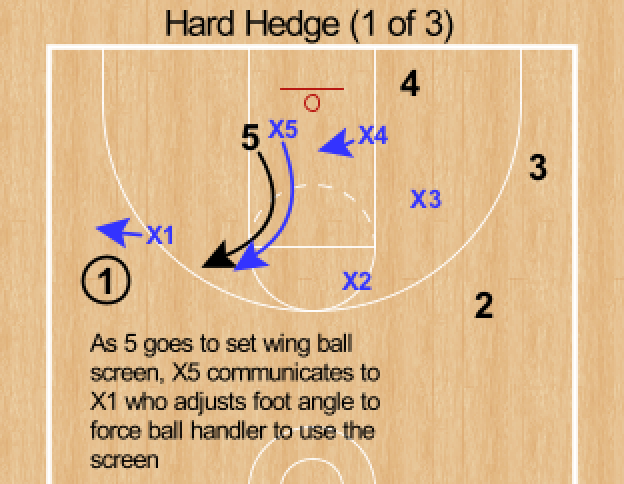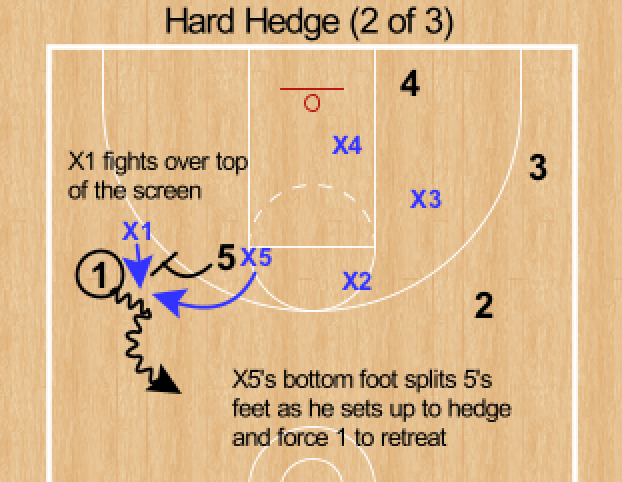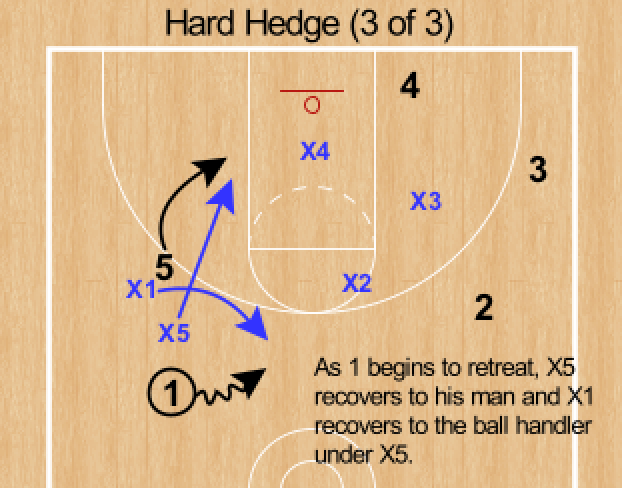Ball Screen Defense—Hard Hedging Ball Screens
What is a hard hedge?
Another popular way teams look to neutralize the pick & roll action is by hard hedging ball screens. Hard hedging involves the screener’s defender getting parallel to the sideline behind the screener, and aggressively sliding high as the ball handler comes off the screen in an effort to slow him down and force him to retreat towards half court.
A few of the advantages of hard hedging ball screens include slowing down the ball handler’s momentum and preventing initial penetration, not allowing the ball handler to pull up off the screen, and hard hedging also makes it difficult to hit the screener rolling to the rim.
This ball screen coverage is a favorite at the NBA level and is most famously used at the collegiate level by Tony Bennet’s Virginia Cavaliers, who we will look at later in this breakdown.
The Basics of Hard Hedging:
As the screener goes to set a ball screen, his defender will be yelling “Screen left!” or “Screen right!” This lets the on-ball defender know the ball screen is coming from and also which direction he needs to force the ball handler—the on-ball defender needs to adjust his foot angle and get into the ball handler to force him into the screen.
In this PNR coverage, you want the ball handler to use the screen as that is where the help is positioned. If the ball handler is able to reject the ball screen, they will be able to get downhill and create as there is no help defender to step up.
Screener’s Defender (The Hedger):
The screener’s defender or hedger should look to maintain contact with the screener as he goes to set the ball screen. As the ball screen is set, the screener’s defender’s bottom foot (foot closest to the baseline) should be positioned between the screener’s feet—at this point the screener’s defender should be parallel with the screener and still maintaining contact. If the screener’s defender does not maintain contact and leaves distance between himself and the screener, the ball handler can potentially split the hard hedge and penetrate.
Now that the hedger is in position, he has to “scream and scare” as the ball handler begins to come off the ball screen. This is a term coined by University of Saint Louis Head Coach Travis Ford, and it simply means the hedger must aggressively show and yell “Ball, Ball, Ball!”
Once the hedger has screamed at and scared the ball handler, he now has two jobs to complete before he can recover back to his man. He must slow the ball handler down by sliding out on the ball handler as he comes off the screen, and he must force him to change direction by ideally forcing him to retreat towards half court.
Once the hedger has slowed the ball handler’s momentum and forced him to retreat towards half court, he sprints back and recovers to his man with high hands.
On-Ball Defender:
The on-ball defender’s first job is to force the ball handler to use the screen as mentioned above.
Once the ball handler is forced into the screen and begins to use it, the on-ball defender must get skinny and slippery and fight over the top of the screen—the on-ball defender cannot get screened
To accomplish this, the on-ball defender must get into the ball handler and stay low as he fights over the top of the screener. The screener is looking to screen or hit the on-ball defender with his upper body. By staying low near the screener’s hips, the on-ball defender decreases his chances of being clipped or hung up on the screen.
Once over the top of the screen, the on-ball defender will go underneath the hedger and recover back to the ball handler. Once the on-ball defender has recovered, he must communicate that to the hedger by saying “Back, back, back!” If the hedger has not already begin to recover back to the screener, this communication signals him to do so.
Off-Ball Defenders:
As the ball screen action is happening, the three off-ball defenders (players not involved in the PNR action), must be in position to help on penetration, tag or the roll and recover to shooters on a skip pass. Typically the lowest off ball defender (often times the other post defender) will be tasked with tagging the roll. While the other two perimeter off ball defenders can help on the action as determined by the other team’s personnel. If you are guarding a shooter, do not help on the ball screen action. If you are guarding a non-shooter, you can stunt if the ball handler turns the corner, etc.
Advantages of Hard Hedging:
Preventing dribble penetration is the first and perhaps biggest advantage of hard hedging ball screens as opposed to less aggressive coverages. This is accomplished first by the screener’s defender’s positioning, and second by pushing the ball handler out or into a retreat. These two things slow the ball handler’s momentum towards the rim and prevents dribble penetration, at least initially.
Since the ball screen is effectively blown up at the point of the screen, it also becomes difficult for the ball handler to pull up off the screen if a shooter.
Hard hedging also makes it difficult for the average ball handler to hit the screener as he rolls to the rim. Yes, the college-ready guard will hit the short roll with a pocket pass, but generally speaking hard hedging obstructs the ball handler’s vision and ability to throw that pass.
The final advantage of hard hedging ball screens is the fact it is an “aggressive” coverage, meaning it is designed to create chaos and force turnovers. Look at the Virginia Cavaliers, a team that plays strictly “pack line”, a defense not known for creating turnovers. However, they consistently sit atop the ACC in steals per game. The reason being they hard hedge every ball screen, and execute to near perfection when doing so.
Disadvantages of Hard Hedging:
While hard hedging can be an effective coverage to neutralize the pick and roll action and limit dribble penetration, it does have it’s disadvantages like any other PNR coverage.
If not properly executed, the offense can easily pick you apart by splitting the hedge, hitting the short roll, or punishing the help. All 5 defenders must be locked in, communicating, and correctly positioned as ball screens are set and used.
Another disadvantage is the pick and pop—if the screener is an outside threat, hard hedging leaves you vulnerable to the pick and pop since the screener’s defender must briefly take the ball while hedging before recovering back. Pick and popping forces a longer recovery for the screener’s defender than if he were to roll to the rim. If the floor is properly spaced, it is almost impossible for the screener’s defender to recover in time on the pick and pop.





